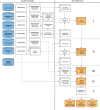A 24-hour population distribution dataset based on mobile phone data from Helsinki Metropolitan Area, Finland
- PMID: 35121755
- PMCID: PMC8816898
- DOI: 10.1038/s41597-021-01113-4
A 24-hour population distribution dataset based on mobile phone data from Helsinki Metropolitan Area, Finland
Abstract
In this article, we present temporally dynamic population distribution data from the Helsinki Metropolitan Area, Finland, at the level of 250 m by 250 m statistical grid cells. An hourly population distribution dataset is provided for regular workdays (Mon - Thu), Saturdays and Sundays. The data are based on aggregated mobile phone data collected by the biggest mobile network operator in Finland. Mobile phone data are assigned to statistical grid cells using an advanced dasymetric interpolation method based on ancillary data about land cover, buildings and a time use survey. The dataset is validated by comparing population register data from Statistics Finland for night hours and a daytime workplace registry. The resulting 24-hour population data can be used to reveal the temporal dynamics of the city, and examine population variations relevant to spatial accessibility analyses, crisis management, planning and beyond.
© 2022. The Author(s).
Conflict of interest statement
The authors declare no competing interests.
Figures















References
-
- Järv O, Tenkanen H, Toivonen T. Enhancing spatial accuracy of mobile phone data using multi-temporal dasymetric interpolation. Int. J. Geogr. Inf. Sci. 2017;31:1630–1651. doi: 10.1080/13658816.2017.1287369. - DOI
-
- Hägerstrand T. What About People in Regional Science? Pap. Reg. Sci. 1970;24:7–24. doi: 10.1111/j.1435-5597.1970.tb01464.x. - DOI
-
- Sheller M, Urry J. The new mobilities paradigm. Environ. Plan. A. 2006;38:207–226. doi: 10.1068/a37268. - DOI
-
- Kwan M-P. Beyond space (as we knew it): Toward temporally integrated geographies of segregation, health, and accessibility. Ann. Assoc. Am. Geogr. 2013;103:1078–1086. doi: 10.1080/00045608.2013.792177. - DOI
-
- Silm, S., Järv, O. & Masso, A. Tracing human mobilities through mobile phones. in (Edward Elgar Publishing) 10.4337/9781788115469.00025 (2020).
Publication types
Grants and funding
LinkOut - more resources
Full Text Sources

